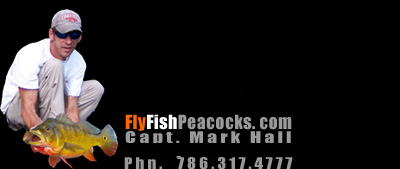

 |
|||||||
 |
|||||||
|
|
|
|
|
|
|
|
|
|
 |
|
Home
| Rates | Book a Trip | Photo
Gallery | FAQ | Links All content Copyright 2005 www.flyfishpeacocks.com |
Florida Peacock BassFlorida Peacock Bass FishingGENERAL FISHING INFORMATION--Cypress Creek Canal provides excellent largemouth bass fishing, and it is the northern limit for predictable catches of butterfly peacock. The boat ramps on this canal are some of the best in southeast Florida. This canal also provides freshwater anglers one of the best opportunities to complete a canal 'trifecta' or 'grand slam' consisting of a butterfly peacock, largemouth bass, and a snook or tarpon. The butterfly peacock is a world renown gamefish that was successfully introduced by the Florida Fish and Wildlife Conservation Commission in the mid-1980s to eat undesirable exotic fishes, and to provide more sportfishing opportunities for anglers in the metropolitan Miami-Ft. Lauderdale area. Fallen trees, canal intersections, sharp bends, and dead ends are generally productive areas for catching most species of fish. Shoreline vegetation, rip-rap, residential seawalls (particularly in lateral canals), and shady areas associated with bridges and culverts all provide excellent places to fish. If there is a strong current in the main canal, spend more time fishing lateral canals and other areas that offer refuge from the current (e.g., cut-outs, bridge pilings, and the downstream side of spillways and culverts). There are fewer butterfly peacock in this canal than in canals further south, but their average size is larger (14.4 inches and 1.8 pounds). Sixty-four percent of the harvestable butterfly peacocks in this canal are greater than 14 inches, and 30% are greater than 15 inches (2.0 pounds). Trophy peacock (those greater than five pounds) have been caught from this and other canals, and we expect the current 9.08 pound state record for this species to ultimately exceed 10-11 pounds. The bag limit for butterfly peacock is two fish per day, only one of which can be greater than 17 inches. Fishing for butterfly peacock is best from March through May, but they are caught consistently throughout the year. Butterfly peacock feed only during daylight and normally close to shore, although schooling peacocks sometimes feed aggressively in open water. Most butterfly peacock are caught on live golden shiners or fast moving artificial lures and flies that imitate small fish. Butterfly peacock are more likely to be caught using live fish for bait than are largemouth bass, which make them an excellent fish for younger anglers, as well as those just learning to bass fish. It is illegal to use goldfish or any other non-native fish for bait, except those legally caught from and used immediately in the same canal. Cypress Creek Canal has more largemouth bass than most other canals in southeast Florida, and fish greater than 20 inches are regularly sampled although the average size is 13 inches (1.0 pounds). Largemouth bass fishing tends to be best during the winter months when the water cools, and at night during the summer months. Plastic worms work well for largemouth bass, but they rarely catch butterfly peacock. The bag limit for largemouth bass is five fish per day, but only one of these can be greater than 14 inches. Snook roam throughout the canal but tend to concentrate under bridges and vegetated shorelines. On calm days, look for tarpon rolling at the surface in the widest parts of lateral canals. The number and quality of panfish over six inches in Cypress Creek Canal is similar to other area canals. Live worms and crickets are the choice baits for many panfish anglers, although fresh bread or bread dough works well, is readily available, and it costs less. Shoreline anglers have plenty of access to these fisheries at the boat ramps, and along roads paralleling and crossing the canal. Some exploring is necessary to find the best locations for shoreline fishing, and always be sure to park cars safely on public right of ways. Cypress Creek Canal anglers might also catch one of several exotic fishes or a native marine invader such as the bigmouth sleeper. Bigmouth sleepers resemble walleye, and are a long/cylindrical fish with a mouth full of sharp teeth. Possible exotic catches include jaguar guapotes and Mayan cichlids from Central America, oscars from South America, and spotted tilapia from Africa. Jaguar guapotes resemble a black crappie (speckled perch) with many small, sharp teeth. Mayan cichlids are colorful and appear similar to mangrove snapper with a turquoise ring around a black spot at the base of its tail. Oscars are a bream-shaped fish with a red or orange circle at the base of its tail, and they have a thick coat of protective mucus on their bodies. Spotted tilapia are bream-shaped, golden in color with black vertical bars or spots, and some have red on them. These exotic fishes were illegally released, pose a threat to native species, are good to eat, and you can keep every one you catch. Cypress Creek Canal and other area canals receive a great deal of fishing pressure, so we encourage anglers to release most, if not all of the butterfly peacock, largemouth bass, snook, and tarpon they catch. If anglers don't release a majority of the sportfish they catch, these high quality fisheries will deteriorate rapidly. |